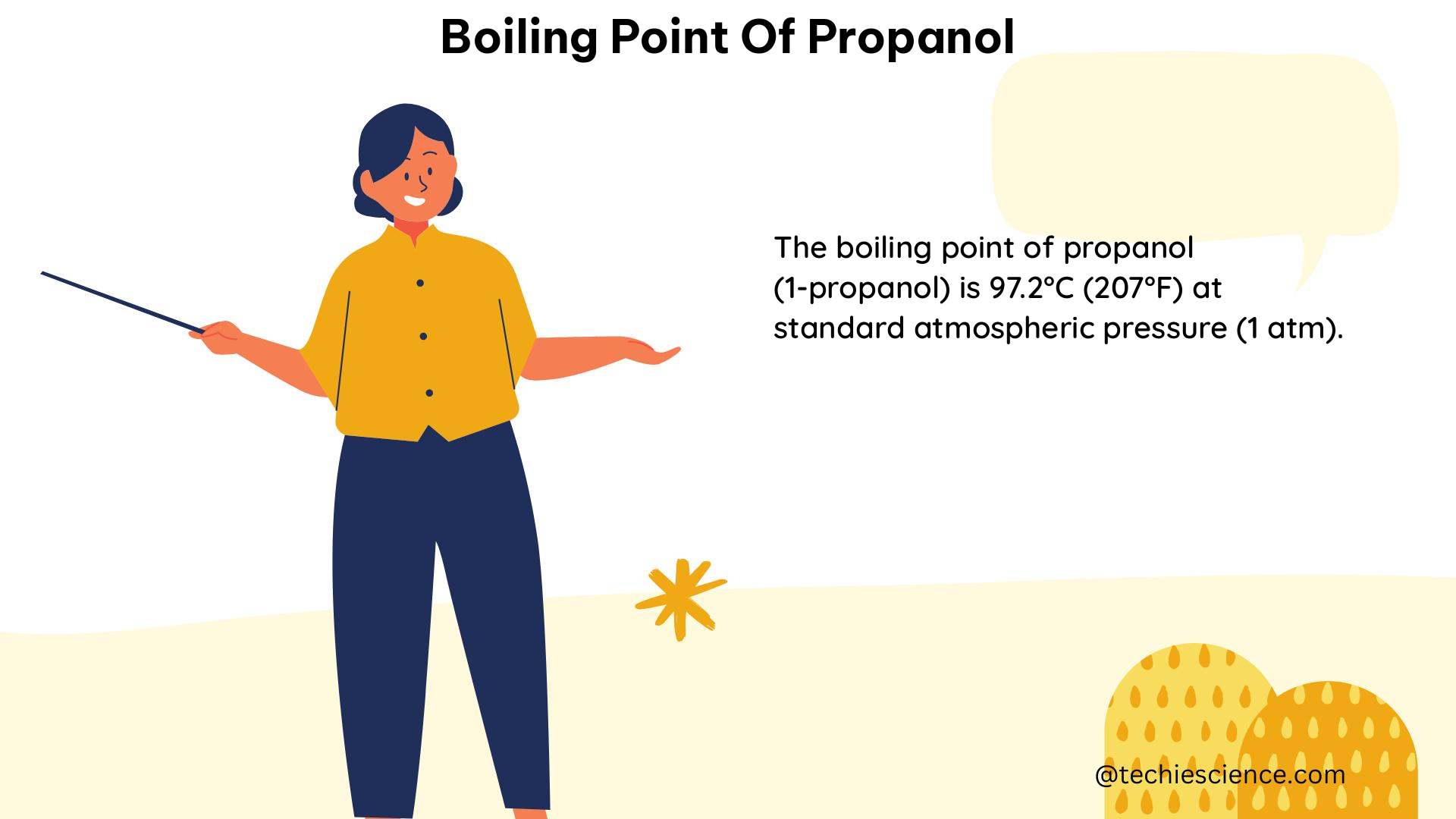The boiling point of 1-propanol, also known as n-propanol, is a crucial property that has significant implications in various scientific and industrial applications. This comprehensive guide delves into the intricacies of the boiling point of 1-propanol, providing a wealth of technical details and practical insights for science students and enthusiasts.
Understanding the Boiling Point of 1-Propanol
The boiling point of 1-propanol is 97°C (207°F) at a pressure of 1 atm (760 torr). This value represents the normal boiling point, which is the temperature at which the vapor pressure of the liquid equals the surrounding atmospheric pressure, causing the liquid to transition into a gas phase.
The Clausius-Clapeyron Equation
The relationship between the boiling point and the surrounding pressure is governed by the Clausius-Clapeyron equation, which can be expressed as:
ln(P2/P1) = (ΔHvap/R) * (1/T1 - 1/T2)
Where:
– P1 and P2 are the vapor pressures at temperatures T1 and T2, respectively
– ΔHvap is the molar enthalpy of vaporization (heat of vaporization) of the substance
– R is the universal gas constant
Using this equation, we can calculate the boiling point of 1-propanol at different pressures. For example, at a pressure of 0.5 atm (380 torr), the boiling point of 1-propanol would be approximately 91°C (196°F).
Heat of Vaporization (ΔHvap)
The heat of vaporization, or enthalpy of vaporization, is another important property related to the boiling point of 1-propanol. The ΔHvap for 1-propanol is 42.1 kJ/mol at the normal boiling point of 97°C.
The ΔHvap represents the amount of energy required to convert a liquid into a gas at a given temperature and pressure. This endothermic process is essential in understanding the energy changes associated with the boiling of 1-propanol.
Vapor Pressure
The vapor pressure of 1-propanol is also a crucial factor in determining its boiling point. At 20°C, the vapor pressure of 1-propanol is 1.9 kPa (14.5 mmHg). This relatively low vapor pressure is consistent with the relatively high boiling point of 1-propanol compared to other alcohols, such as ethanol or methanol.
The vapor pressure of a substance is related to its boiling point through the Clausius-Clapeyron equation, as mentioned earlier. By understanding the vapor pressure of 1-propanol, we can predict its boiling point at different temperatures and pressures.
Factors Affecting the Boiling Point of 1-Propanol

The boiling point of 1-propanol can be influenced by various factors, including:
-
Pressure: As discussed, the boiling point of 1-propanol is directly related to the surrounding pressure. Lower pressures result in lower boiling points, while higher pressures lead to higher boiling points.
-
Purity: The presence of impurities in the 1-propanol sample can affect its boiling point. Impurities can interact with the 1-propanol molecules, altering the vapor pressure and, consequently, the boiling point.
-
Molecular Structure: The specific molecular structure of 1-propanol, with its three-carbon chain and hydroxyl group, contributes to its unique boiling point. Variations in the molecular structure of alcohols can lead to differences in their boiling points.
-
Intermolecular Forces: The intermolecular forces, such as hydrogen bonding, between 1-propanol molecules play a role in determining the boiling point. Stronger intermolecular forces generally result in higher boiling points.
Practical Applications and Measurements
The boiling point of 1-propanol has numerous practical applications in various fields, including:
-
Chemical Processes: The boiling point of 1-propanol is crucial in chemical reactions, distillation, and purification processes where the precise control of temperature is essential.
-
Solvent Properties: The boiling point of 1-propanol influences its use as a solvent in chemical and industrial applications, where the volatility and ease of evaporation are important factors.
-
Fuel and Fuel Additives: 1-propanol can be used as a fuel or fuel additive, and its boiling point is a key parameter in the design and optimization of combustion engines.
To measure the boiling point of 1-propanol in a laboratory setting, you can use a simple distillation setup. By heating a sample of 1-propanol and measuring the temperature of the vapor as it leaves the flask or beaker, you can determine the boiling point. It’s important to ensure that the pressure is maintained at 1 atm (760 torr) to obtain the normal boiling point.
Conclusion
The boiling point of 1-propanol is a fundamental property with far-reaching implications in various scientific and industrial applications. By understanding the factors that influence the boiling point, such as pressure, purity, molecular structure, and intermolecular forces, we can gain valuable insights into the behavior and properties of this important alcohol. This comprehensive guide has provided a wealth of technical details and practical information to help science students and enthusiasts deepen their understanding of the boiling point of 1-propanol.
References:
- NIST Chemistry WebBook
- Phase Transitions: Melting, Boiling, and Subliming
- Thermodynamic Properties of 1-Propanol
- Environmental Health Criteria 102: 1-Propanol

The lambdageeks.com Core SME Team is a group of experienced subject matter experts from diverse scientific and technical fields including Physics, Chemistry, Technology,Electronics & Electrical Engineering, Automotive, Mechanical Engineering. Our team collaborates to create high-quality, well-researched articles on a wide range of science and technology topics for the lambdageeks.com website.
All Our Senior SME are having more than 7 Years of experience in the respective fields . They are either Working Industry Professionals or assocaited With different Universities. Refer Our Authors Page to get to know About our Core SMEs.